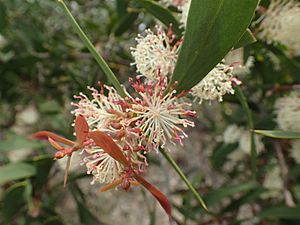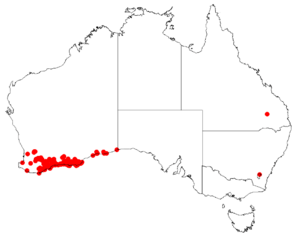Frog hakea facts for kids
Quick facts for kids Frog hakea |
|
|---|---|
 |
|
| Hakea nitida growing near the Stirling Range National Park | |
| Scientific classification | |
| Genus: |
Hakea
|
| Species: |
nitida
|
 |
|
| Occurrence data from AVH | |
Hakea nitida, often called the frog hakea or shining hakea, is a type of shrub. It belongs to the Proteaceae plant family. This plant is special because it grows only in certain parts of Western Australia. You can find it in the southern Wheatbelt, Great Southern, and Goldfields-Esperance regions.
Contents
What the Frog Hakea Looks Like
The frog hakea is an upright shrub. It usually grows to be about 1 to 3 meters (3 to 10 feet) tall. This plant does not have a special woody base called a lignotuber.
Flowers and Leaves
The frog hakea blooms from July to September. During this time, it produces pretty white-cream and yellow flowers. Its branches are smooth and not covered in a waxy layer.
The leaves are flat and stiff. They are shaped like a narrow oval or wider at the top. These leaves are usually 1.5 to 9 centimeters (0.6 to 3.5 inches) long. They are also 10 to 30 millimeters (0.4 to 1.2 inches) wide.
Unique Fruit Pods
The plant produces groups of 16 to 36 flowers. After flowering, it forms interesting fruit pods. These pods are shaped like an oval and are 2.5 to 3.5 centimeters (1 to 1.4 inches) long. They are also 1.5 to 2.5 centimeters (0.6 to 1 inch) wide.
The fruit pods have a bumpy, black surface. They also have small "horns" that are about 6 millimeters (0.24 inches) long. These seed pods look a lot like warty toads or frogs. This is why the plant has the unusual common name, the frog hakea!
How the Frog Hakea Got Its Name
The frog hakea was first officially described in 1810. A botanist named Robert Brown gave it its scientific name. He published his description in a scientific paper.
The second part of its scientific name, nitida, comes from a Latin word. This Latin word means "bright," "shining," or "elegant." This name refers to the plant's leaves, which are usually glossy and shiny.
Where the Frog Hakea Grows
The frog hakea grows in the southern parts of Western Australia. You can find it from Busselton all the way to Eucla. It likes to grow in sandy-loam, clay, and gravel soils.
This plant is often found in areas with mallee (a type of eucalyptus woodland) or heath (shrubland). It is also a good ornamental shrub. Plus, it provides a great home and food for local wildlife.
Conservation Status
The Western Australian Government has looked at the frog hakea. They have classified Hakea nitida as not threatened. This means it is not currently at risk of disappearing.
Gallery




